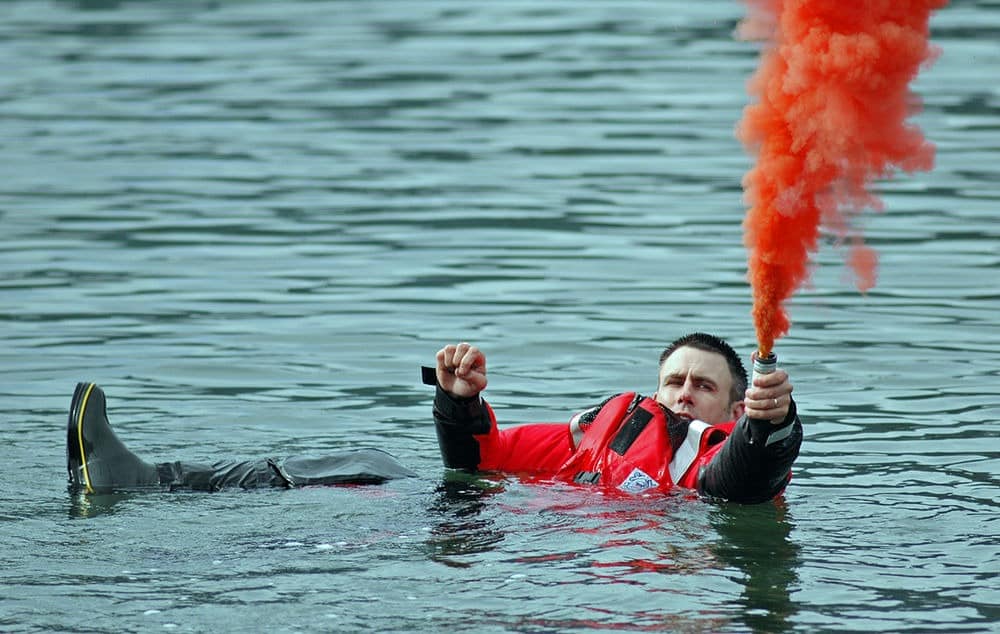
With few exceptions, the U.S. Coast Guard requires vessels over 16 feet length overall with mechanical power to carry readily accessible, serviceable visual distress signals (VDS) on board for both daytime and nighttime uses. These include pyrotechnic and nonpyrotechnic devices, such as flags, flares and lights. Here’s what’s on the market today and a glimpse of things to come. Thanks go out to Marty Jackson, staff engineer with the U.S. Coast Guard, who works for the Office of Design and Engineering Standards, Lifesaving and Fire Safety Division, who helped in preparing this story.
Nonpyrotechnic
Flags The Coast Guard-approved flag for daytime use only is a 3-foot by 3-foot orange background displaying a black square and a black circle. Deploy this flag by tying it to a mast, antenna, boat structure, boathook, fishing rod, etc. These flags are inexpensive, stow well and never go out of date. The downside is they don’t scream for attention quite as well as other daytime signals, such as smoke signals.
Electric Lights
There is only one Coast Guard-approved light, and it is for nighttime use only: the Weems and Plath SOS Distress Light (model C-1001, $100, weems-plath.com). You must carry a distress flag or other approved daytime signal for the light to be compliant. This floating light fits in a rod holder and flashes a continuous SOS for hours. Its long-lasting signal time eliminates the need for short-lived, potentially dangerous pyrotechnics. On the other hand, this bright-white flasher might not grab the attention of boaters trained to look for a burning red flare. Therefore, while this light fulfills your nighttime-carriage requirement, I recommend using it in conjunction with pyrotechnics.
There are also non-approved electronic flares that belong in the awareness of any savvy skipper. These are great for getting attention, and one from a company whose products we have tested is the EF-20A-1 Electronic Flare from North American Survival Systems.
Others
Flying a national flag upside down, displaying international code flags C and N (“Charlie” and “November”), three shots from a gun, prolonged horn blasts and more are also ways to signal distress, but they do not meet approval requirements for what must be carried aboard.
Pyrotechnics
Flares Pyrotechnics fall into three classifications: floating, handheld and aerial (meteor and parachute). Floating and handheld red-smoke flares are approved for daytime use only. Red flares, whether handheld or aerial, are for daytime and nighttime uses. The notable difference among them is the distance from which they are visible to a rescuer at sea level.
All these pyrotechnics have the advantages of economy, reliability and high visibility, as well as recognition as the traditional distress signals, but they have been known to cause physical injury (burns) and, rarely, onboard fire when not properly ignited or handled.
Another disadvantage is their limited shelf lives, which means they must be replaced periodically to meet Coast Guard requirements. Disposing of outdated flares is difficult because local ordinances vary from jurisdiction to jurisdiction. Check your local EPA office or the nearest Coast Guard facility for current rules.
Coming Up
Pyrotechnics are pretty much fully developed. The Coast Guard is currently working with the Radio Technical Commission for Maritime Services to develop better battery-operated electronic visual distress signal devices (eVDSDs). The goal is to meet the existing signal characteristics and intensities of present pyrotechnics while providing much longer operation times and greater user safety.
* * * * *
The U.S. Coast Guard is asking all boat owners and operators to help reduce fatalities, injuries, property damage, and associated healthcare costs related to recreational boating accidents by taking personal responsibility for their own safety and the safety of their passengers. Essential steps include: wearing a life jacket at all times and requiring passengers to do the same; never boating under the influence (BUI); successfully completing a boating safety course; and getting a Vessel Safety Check (VSC) annually from local U.S. Coast Guard Auxiliary, United States Power Squadrons(r), or your state boating agency’s Vessel Examiners. The U.S. Coast Guard reminds all boaters to “Boat Responsibly!” For more tips on boating safety, visit www.uscgboating.org.








